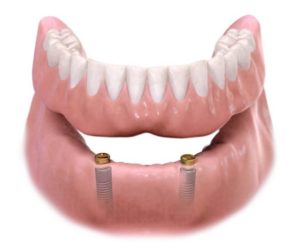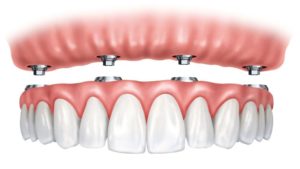When you’ve lost all your teeth or are facing losing them all and having to decide on replacement options, there are several. Once upon a time, the only option was removable dentures. The upside to conventional removable dentures is that they’re not very expensive. But there are MANY downsides, as anyone who has had to live with them can tell you! They’re bulky, you need to remove them several times a day to clean them, they move around in your mouth easily, get food trapped underneath and can be challenging to eat many types of food with.
It’s a daily burden to not be comfortable with your teeth, and to not be able to eat the foods you love most. It feels terrible to be held back from being able to speak or laugh confidently, without fear of your teeth slipping around or falling down.
If you are missing all of your teeth on a given arch, or in your whole mouth, removable or fixed implant dentures may be the best solution for you.
It’s important to look beyond just the cost, when it comes to deciding just HOW to replace a full set of teeth. It’s also important to understand the different types of implant dentures available and think through a few factors before deciding which procedure is best for you.
WHAT IS AN IMPLANT DENTURE?
Well, there are a few different types. First of all, a dental implant is an artificial titanium tooth and root fixture that is set into your jawbone, which is used to stabilize or support a denture. The initial stage is to place the implant. Over the period of a few months, the artificial root (implant) root and bone jawbone fuse together forming a permanent hold. Once they’re fully fused/integrated, the implants can be used to support either a removable or a fixed implant denture.

REMOVABLE IMPLANT DENTURES:
Removable implant dentures, (the correct term for these are “overdentures”, and sometimes referred to as “snap-on dentures”), are similar to traditional non-implant dentures in the way they’re fabricated and the way they look. These can be supported by as few as two (2) dental implants, keeping the cost lower than other implant options.
Conventional, non-implant removable dentures use suction or strong adhesives to keep them in place and must be removed daily to clean. Because they cover the entire palate on the upper arch, people with gag reflexes do not do well with them. They also limit your ability to taste and feel your food like normal, because of the prosthesis covering so much of the soft tissues. They rest completely on the gums, sometimes resulting in sore spots and needing regular adjustments, as the gun tissue slowly resorbs from the pressure placed on them all day, every day.
Removable implant dentures function in a similar way, except for one important factor: Instead of resting directly on the gums, they rest on the implants, which they snap onto with special attachment fittings. The difference is that the supportive implants provide a much more comfortable and secure fit, and they do not move around. The teeth can then be ‘snapped’ on and off of the implants for daily cleaning. The attachments also need to be replaced every so often, (this varies from every few months for some, to every year, for others), resulting in the need for more regular follow up maintenance visits.
Removable implant dentures are often favored by patients who either
(A) don’t have the bone mass to support more implants to allow for a fixed/non-removable denture or bridge option, or
(B) individuals who are used to removable dentures and the cleaning process associated with them, and like the idea of being able to keep them impeccably clean.

FIXED IMPLANT DENTURES
Fixed Implant Dentures, as the name implies, are dentures that are “fixed” in the mouth; that are not removable by the patient. The correct term for this type of prosthesis is either a “Fixed Implant Denture” or a “Hybrid Prosthesis”. They are also referred to by several other names, marketed to the public, such as “All-On4”, All-On-X”, etc. It’s all the same prosthesis, only marketed different ways by different doctors.
These prostheses are screwed onto the implants and are only removable by your dentist/prosthodontist. Second to fixed implant bridges, which require more implants, fixed implant dentures fixtures and are the closest thing to having a natural set of teeth. They’re strong and can take great chewing forces without moving at all, so you can eat whatever you would eat with natural teeth without any issues. Taking care of them is similar to taking care of your natural teeth, except for the need to floss daily underneath, between the prosthesis and your gums to keep any plaque and debris from accumulating between them. This takes a little practice, but is well worth the effort. It will manage plaque, bad breath and potential gum infection and/or resorption. (**It’s important that when this type of prosthesis is fabricated, that the design is made to be convex in nature, not concave. Otherwise, the plaque and debris accumulation becomes a nasty problem and impossible to keep really clean. (**See photos).
In a way, this helps people forget that they even have dentures! This is bound to increase your confidence and make your smile feel like your own.
SO, WHICH WILL IT BE? FIXED OR REMOVABLE?
In the end, the best way to decide which option is best suited for you, is to seek help from an expert; a Prosthodontist.
Dr. Tan, at The Dallas Dental Implant Center can help you point you in the right direction. To get in touch and schedule a consultation, call 214-956-9100 today.
Our consultation is complimentary.

